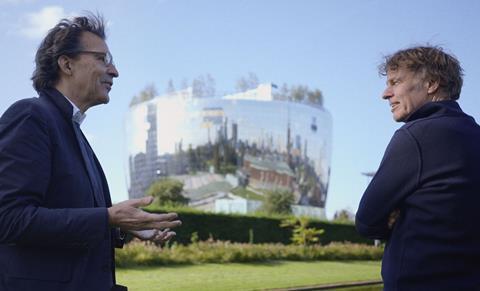Rotterdam’s state-of-the-art statement by Sonia Herman Dolz is an irrestible advert for an edifice

Dir. Sonia Herman Dolz. Netherlands. 2023. 86 mins.
The title of Sonia Herman Dolz’s documentary DEPOT – Reflecting Boijmans can be taken quite literally. The building in question, which opened in Rotterdam in 2021, is famous for its reflecting surface: resembling a huge metallic teacup, Depot’s structure reflects not just the city itself but in particular the Museum Boijmans van Beuningen, whose collection it currently houses. This celebratory documentary by the director of related 2015 study Conducting Boijmans – other films include Lágrimas negras (1998) and This Is Me (2000) – serves as a history of the building and a friendly invitation to it.
An irresistible advert for an extraordinary edifice, in which the sense of artistic and architectural possibility is nothing less than vertiginous
Premiered in Rotterdam earlier this year, and recently shown at the Chicago Film Festival, it deserves further exposure anywhere there is an interest in contemporary architecture, art history and the joys and challenges of curatorship.
Dividing her film into several chapters, with a prologue, epilogue and spare bookending voice-over, Herman Dolz traces the construction and opening of an extraordinary building that has not only transformed the landscape of a city, but also brought an innovative approach to the practice of art storage and exhibition. Using archive footage, she fills us in on the history of the original Boijmans Museum, which was founded in 1849, and the current Boijmans building designed by Ad van der Steur, which opened in 1935.
This monumental landmark of modernist architecture has been an eminent fixture on the European art scene for nearly a century, but problems with water leakage and asbestos have made it necessary to shut down the building for renovation. The collection has therefore been moved to a new building directly facing it – the purpose-built Depot, created to store and preserve a collection of 151,317 individual pieces (as a helpful end title specifies) but also to give the public access to the art in an imaginative and innovative way.
The film highlights the theme of exploration, figurative and literal, beginning with the report of the Europe-wide research trip that went into designing the 1935 building, and following with the walks through that building – now eerily deserted – undertaken by the Boijmans and Depot director (until last year) Sjarel Ex and Depot’s architect Winy Maas, who serve as genial, if occasionally blokey, guides to the new project.
Herman Dolz and her extensive camera crew glean some magnificent images of Depot rising up, rather like Brueghel’s Tower of Babel – an image referenced here – with the Rotterdam sky intersected by huge mantis-like cranes hauling pre-built staircases as well as the plants that fill Depot’s roof garden. The interior of Depot (shown both before and after the artworks’ installation) is a deep well of staircases and lifts, like a futuristic version of the labyrinthine architectural fantasies of 18th-century artist Piranesi, whose etchings are a prize exhibit of the venue.
Total accessibility of the collection is one of Depot’s aims: the collection is housed in a mobile storage system, with paintings hung on sliding grilles and exhibited in combinations whose logic intriguingly flouts expectations of where pieces belong. A collection that takes in everything from Bosch to Basquiat, with works in two and three dimensions, intermingles promiscuously to evoke a sense of artistic infinity – as much like Borges’s Library of Babel as Brueghel’s Tower.
Highlights of the film include an account of the dismantling and relocation of Maurizio Cattelan’s droll but uncanny ’Manhole’ (a hyperreal sculpture of a man peering through a hole in the floor, and now suspended in Depot’s central shaft); a visit from two elderly women, viewing a family portrait by German artist Max Beckmann, in which one of them appears as a girl; and a larky appearance by star video artist Pippilotti Rist, there to install the psychedelic projection that brings Depot and its surroundings vividly alive at night.
Music by Paul M. van Brugge – including sung opening credits, and some stirring trumpet flourishes from Jan van Duikeren – add a buoyant, cordial feel to a piece that’s much too elegant and playful to be categorised as a municipal information film. That said, Herman Dolz’s DEPOT does serve as an irresistible advert for an extraordinary edifice, in which the sense of artistic and architectural possibility is nothing less than vertiginous.
Production company: Sonia Herman Dolz
International sales: Sonia Herman Dolz, sonia@soniahermandolz.com
Producer: Sonia Herman Dolz
Screenplay: Sonia Herman Dolz
Cinematography: Paul van den Bos, Stef Tijdink, Marco Nauta, Arne Verbrugh, Ruben Hamelink, Mano Szollosi, Sonia Herman Dolz
Editing: Rémi van der Heiden, Sonia Herman Dolz
Music: Paul M. van Brugge






















